The other side of Egypt: Much more than the pyramids
The North African country, one of the cradles of civilization, hides places unknown to many. Visitors can discover the location of the oracle of Alexander the Great, the great unknown Egyptian Mediterranean coast, or the secrets of the city of Alexandria
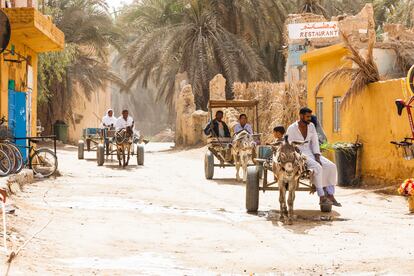
In Egypt, everything seems to revolve around the Nile, but this isn’t so. Apart from the cruises that travel along the river, the famous pyramids, the mysterious pharaonic temples of the Upper Nile and the fascinating city of Cairo, there’s so much more of Egypt to visit and revisit, in a country that has seen all the cultures of classical antiquity.
Here are the great destinations to go beyond the classic attractions of Egypt:
The Siwa Oasis: the oracle that Alexander the Great used to consult
Not many tourists stray from the Nile, but a getaway to places such as the Western Desert is worth it. It’s older than the pyramids and as spectacular as any temple — pure beauty. The surreal rock shapes of the White Desert and the gigantic undulating dunes of the Great Sand Sea offer unforgettable images for any traveler who ventures to discover this sometimes forgotten side of the country.
Among a picturesque landscape of palm plantations and hot springs, authentic Egyptian rural life is maintained in the five oases of this landscape, just as it has been throughout millennia. It’s a quiet destination, where there’s no shortage of adventure: we can explore the alleys of El-Qasr in the Dakhla Oasis, see the sunset from Gebel al-Ingleez in the Bahariya Oasis, walk among the palm trees of Siwa, go on excursions through the desert and enjoy the pleasure of relaxing within the tranquil life of an oasis.
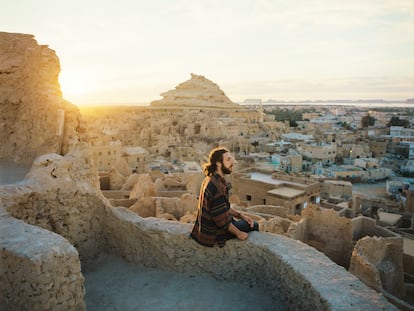
Siwa — the most remote of the oases in the Western Desert — stands on the edge of the Great Sand Sea, about 30 miles from the border with Libya. It’s the oasis par excellence, just as we all imagine it. Alexander the Great traveled here to consult his famous oracle. For that reason alone it would be worth a visit, but it’s also an ideal place to relax after traveling along the Nile. A bicycle ride among the palm trees, an excursion through the desert towards hot springs, sliding down the slopes of the dunes, along with many other experiences justify the trip to this oasis.
Siwa’s geographic isolation has helped protect a culture completely distinct from the rest of Egypt, preserving regional traditions and Siwi, the local Berber language. It all comes from a long past: Siwa’s oldest monuments include a temple — that of the Oracle of Amun — from when the Assyrians invaded Egypt. One of the most enduring legends of the Western Desert is that of the lost army of the Persian King Cambyses II, who was sent to destroy the oracle, but disappeared in the desert. This increased its prestige and reinforced the political power of the priests of Amun.
In the surroundings of Siwa
In Siwa, there are many active and bubbling fountains hidden among the forests and palm trees, such as the Cleopatra Fountain, the Fatnas Fountain, or the salt lake of Bir Wahed. Watching the sunset while bathing here is a surreal experience.
But if we’re attracted to the famous Oracle — as the ancients were — we’ll have to go to Aghurmi, two miles east of the contemporary city of Siwa. It was here that Alexander the Great consulted the famous oracle in 331 BC.
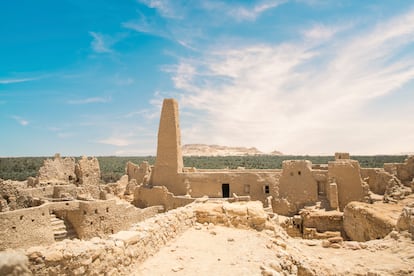
Around Siwa, there are other villages, ruins and fountains that are worth visiting if there’s time. Shiatta, for instance, is a spectacular salt lake surrounded by palm trees, on the border of the Sand Sea. Or Bilad Ar Rum, the city of the Romans, which is about 10 miles away. It’s home to some 100 tombs cut into the rock of the nearby hills, as well as the ruins of a stone temple… one of the possible final resting places of Alexander the Great. Nearby is where an archaeologist claimed, in 1995, to have found the tomb of the great conqueror (although this has never been confirmed).
A picturesque oasis in the Western Desert
You only have to travel a couple of hours through the desert to enjoy the beauty and absolute isolation of the wildest part of Egypt. The best thing to do to experience the solitude of the Western Desert is to camp under the starry sky in the White Desert National Park, or venture into the dunes of the Great Sand Sea.
The El Kharga Oasis is the closest to the Nile Valley, but also the most modern and, therefore, the least untouched. Important desert trade routes passed through here for a long time; it was a prosperous and strategic place. Today, it’s the largest city in the Western Desert, with wide boulevards and nondescript concrete blocks. Still, to compensate, it has some interesting places, such as the Necropolis of El Bagawat — one of the oldest and best preserved Christian cemeteries in the world — or the Monastery of Al-Kashef, magnificent adobe ruins from the early days of Christianity. There are also huge sandstone temples such as Qasr el-Ghueita, with enormous walls, which keep old stories from the times of the pharaohs, or Greco-Roman temples such as Qasr el-Zayyan, one of the most important monuments of the oasis.
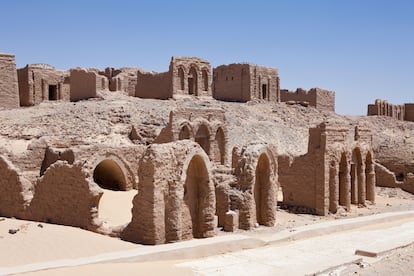
For travelers, another oasis of this great desert is Dakhla, with more than a dozen villages. In this case, it meets the most romantic expectations of life in an oasis. The ruined adobe villages, palm forests and hot springs surrounding the city of Dakhla convey the essence of tranquil oasis life and are some of the most evocative images of the Western Desert.
The White Desert and the golden mummies of Bahariya
Farafra is the smallest oasis in the Western Desert, hence it often goes unnoticed. There are few tourists and it’s a quiet place, with a single city: Qasr al-Farafra. Only a pile of rubble remains of what was once an ancient Roman fortress, but from here, you can take an excursion to the White Desert National Park (Sahra al-Beida). There, you can feel like Alice through the looking glass. About 12 miles northeast of Farafra, on the east side of the highway, almost supernatural capitals of blinding white limestone rise from the ground, warped by the desert winds into familiar and unknown shapes. These sculptural formations are especially impressive at dawn or dusk, when the sun turns them an orange-pink hue, or under the light of the moon, which turns the desert into a ghostly arctic landscape.
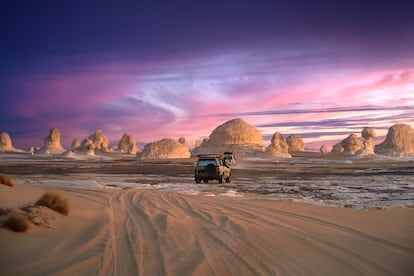
And, in addition to the White Desert, there’s also a Black Desert, which you reach from Bahariya, one of the most attractive oases in Egypt and also the most accessible, covered by lush palm trees with dozens of natural springs inviting you for a dip. All around, plateaus of sand and rock are a perfect introduction to the barren beauty of the Western Desert. In Roman times, this oasis was an agricultural center where wine was produced that was sold in the Nile Valley, as well as in Rome. Recently, it has become popular again, due to impressive archeological discoveries, such as the Golden Mummies. It has also become an easy access point to the Black and White Deserts.
Alexandria, the Greek face of Egypt
This splendid and luminous Mediterranean city connects directly with Greece. Founded in 331 BC by Alexander the Great, the towering lighthouse — Pharos — marked the entrance to the ancient harbor and was one of the seven wonders of the world, while the vast library was considered to be the archive of ancient knowledge. Eventually, however, the lighthouse collapsed and the library was burned. A part of the ancient city disappeared under the sea and another part was swallowed by the modern city. But despite everything, Alexandria remains an eternal city. Today, the imposing modern library of Alexandria stands among the faded vestiges of what was a wonderful corniche or promenade in the 19th century, the symbol of the city’s latest incarnation as Egypt’s cultural capital.
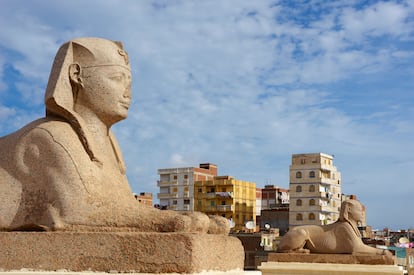
Traveling to Alexandria today allows us to appreciate the most European side of Egypt. All you have to do is contemplate the last vestiges of its 19th-century majesty while sitting in a vintage cafe and strolling through the streets of the charismatic Anfushi neighborhood at night. And, of course, as is obligatory, one must visit the modern version of the ancient wonder: the library, which in addition to books includes museums of antiquities, manuscripts, and art.
A city tour
There’s much more to see in Alexandria than just strolling along the corniche: the Alexandria National Museum, housed in a well-restored Italian villa, is worth a visit, especially for the Greco-Roman remains. In Kom el-Dikka — a residential neighborhood during Greco-Roman times — we find the white marble ruins of the only Roman amphitheater found in Egypt. And, in the Cavafy Museum, we remember another of the illustrious tourists who ended up staying to live: the Greek poet Constantine Cavafy. His apartment is a mandatory pilgrimage site for lovers of his poetry.
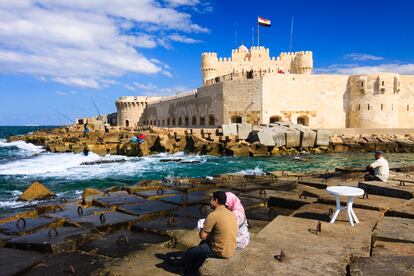
We still have many mosques to see. Some are majestic, like the one dedicated to Abu al-Abbas al-Mursi, a 13th century Sufi saint from Spain. Or Fort Qaitbey, dominated by strong walls, which can be reached by taking a pleasant walk along the corniche. It’s supposedly here that the famous lighthouse stood for 17 centuries, before it was destroyed by an earthquake in 1303.
Alexandria, coffee and literature
Since the beginning of the 20th century, the city’s culture has revolved around cafés where, for decades, famous writers met to chat about this city that they didn’t fully understand. Many of those old establishments are preserved. Relics of other times, they’re worth visiting to admire their majestic decoration.
Among the classics is Délices, a former tea shop that has been in business since 1922. Its high ceilings continue to evoke the atmosphere of the Old World, when the pastry shop was a supplier to Egyptian royalty, or when the café was one of the favorite places of Allied soldiers during World War II.
Another must-see is the Sofianopoulo Coffee Store, where you can smell the coffee from half-a-block away. In any other part of the world, this venerable store would be a museum. Dominated by huge silver coffee grinders, piles of shiny beans and the aroma of freshly-roasted coffee, it’s a caffeine haven and serves coffees fit for a king.
The other ingredient of the city is its literature. Its writers attract as many travelers as its monuments. More than one tourist arrives in the city with a copy of The Alexandria Quartet, by Lawrence Durrell, under their arm. The place evoked by Durrell, E. M. Forster and the Alexandrian poet Constantine Cavafy can still be perceived in the buildings downtown.
Of Greek parents, Cavafy (1863-1933) lived for a short time in Alexandria. In some of his poems, he resurrects characters from the Ptolemaic era and classical Greece. In others, he captures fragments of the city through his routines or chance encounters. Cavafy discovered the English-speaking world through E. M. Forster (1879-1970), the famous English novelist who spent three years in the city and compiled what he considered to be an “antique” — Alexandria: A History and a Guide — which featured an introduction to the city written by Lawrence Durrell (1912-1990), who arrived in Egypt 22 years after Forster’s departure. Durrell had been evacuated from Greece and resented Alexandria, a city he defined as a “squalid, crumbling, finished Neapolitan city.”
The neglected Mediterranean coast
Overshadowed by the originality and natural wonders of the other Egyptian coast — that of the Red Sea — we forget that the country also has a good stretch of Mediterranean coast. Here, in the surroundings of Alexandria, we find historical places of enormous importance, such as Abukir, Rosetta, or El Alamein, as well as the tourist resorts of Sidi Abdel Rahman or Mersa Matruh, frequented by many Egyptians as well as foreigners.
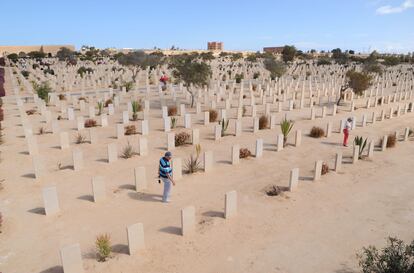
The city of El Alamein is famous for the decisive Allied victory during World War II. The memory isn’t very happy, but today, joy reigns on the neighboring beaches. With its fine sands and crystal clear waters, it’s a beach area for both single travelers and families. From the old days, there remains the El Alamein Military Cemetery, a moving place with more than 7,000 graves arranged in rows among well-kept desert plants. There’s also a German war monument very close to a small but very pleasant beach, light years away from the crowded Alexandrian beaches.
Getaway to the Delta and the surroundings of Cairo
To delve a little deeper into the culture and history of Egypt, in the area surrounding Cairo, the capital, there are many other important sites that are rarely part of typical itineraries. Although few of them could be classified as a must-see — except for the majestic and ancient enclave of Saqqara, south of the city — anyone who has time and goes beyond the typical tour of Egypt will enjoy visiting this lesser-known region. Off route are the Coptic monasteries of Wadi Natrun, which date back 17 centuries. You can spend the morning at the Birqash Camel Market to immerse yourself in a chaotic world not for the squeamish, or get up close to the prehistoric whale skeletons of Wadi Al-Hitan, one of the most important evolutionary enclaves in the world. The rest of the collapsed ruins in the region are practically at the disposal of the traveler who ventures here.
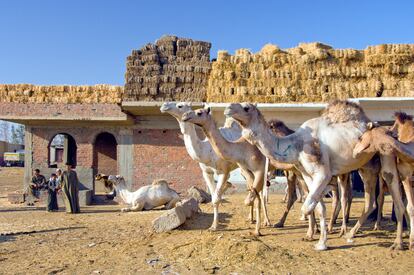
Diving in the Red Sea
International conflicts mean that the Egyptian coast of the Red Sea isn’t going through its best moment. Still, its charms are indisputable: an underwater landscape of coral cliffs, colorful fish and shipwrecks of disturbing beauty. Travelers can also be inspired by Jacques Cousteau and explore shipwrecks, such as the enigmatic World War II freighter Thistlegorm, a fascinating museum on the seabed. But even with simple goggles and fins, it’s possible to contemplate a part of this beautiful underwater world.
Behind the sea and the large tourist resorts on the coast, we mustn’t forget the interior: to the south of the tourist city of Hurghada lies the epic and rugged expanse of the Eastern Desert, a little-visited area crisscrossed by ancient trade routes and dotted with ancient rock art and lonely ruins, every desert adventurer’s dream. And, in the arid mountains of the northern Red Sea coast, some of the most important sites of early Christianity can be found, such as the Coptic monasteries of Saint Anthony and Saint Paul, sacred places of the Coptic faith. The monasteries are only 15 miles from each other, but due to the escarpments and the Gebel al-Galala al-Qibliya plateau (between 3,000 and 4,300 feet above sea level), the distance between them by road is 52 miles.
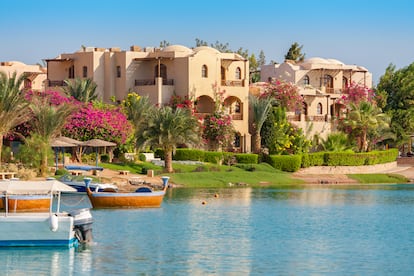
If you prefer to stay on the coast, El Gouna is possibly the best resort in Egypt. Egyptian billionaire Onsi Sawiris had it built near lagoons and canals, to ensure that there were plenty of beaches and that most of the facilities had water views. It’s frequented by high-income Egyptians and Europeans on organized trips. It has 16 hotels, an 18-hole golf course, villas, boutiques, restaurants and bars and, above all, it’s a paradise for water sports and an alternative base from which to explore diving sites near Hurghada. This is the best-known destination in the area and the one that tourists usually combine with a visit to the Nile Valley.
The Suez Canal and the decadent charm of the Egyptian belle époque
The Suez Canal — Egypt’s glorious engineering triumph over nature — cuts through Egypt and its Sinai Peninsula, while also separating Africa from Asia. The 120-mile-long canal was an extraordinary achievement of Egypt’s belle époque, a glorious period that ended in bankruptcy and broken dreams. That era also saw the birth of Port Said and Ismailia, two cities near the canal whose streets are still marked by those brief times of greatness and the unmistakable faded charm of their architecture.
This is an area of the country that’s not often visited (even less so now due to the international situation). Still, anyone interested in the modern history of Egypt will enjoy the remnants of its ancient splendor. And, while the canal zone doesn’t have enormous ruins or colossal temples, leisurely travelers will enjoy its calm pace of life. For example, Port Said is a city that, at the end of the 19th century, represented vice and sin in Egypt. The drunken sailors and bustling brothels have long since disappeared, but the disorderly and grandiose architecture — now in decline — continues to evoke that period. The Suez Canal is the reason for Port Said: the elevated pedestrian promenade that runs along the docks allows you to see the canal’s northern entrance up close and admire the supertanker traffic.
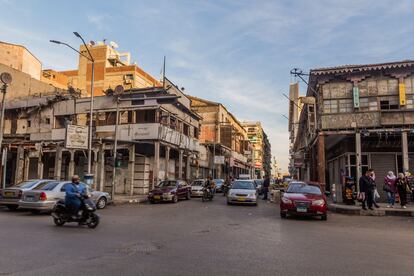
Another of the canal cities is Ismailia. It was founded by Ismail Pasha — viceroy of Egypt in the 1860s — while the Suez Canal was being built. The city was the temporary home of Ferdinand de Lesseps, director of the Suez Canal Company, until he finished the project. Ismailia grew up following the style of the French who settled in Egypt during the colonial era. Today, its center — with elegant colonial streets, large gardens, and villas from the late-19th century — is one of the quietest and most picturesque neighborhoods in the country. The heart of the city, and the area most worth visiting, is the old European quarter near Sharia Thawra and the central square, Midan Al Gomhuriyya.
The magic of Sinai: monasteries, coral reefs and starry nights in the desert
And we still have to discover the Sinai, Egypt’s peninsula that has aroused the interest of great travelers for centuries, both for its deep religious significance and for its strategic position as a crossroads of empires: prophets, pilgrims, conquerors and exiles have left their mark in these sands. In recent years, security fears have caused tourism to decline. It seems that, time and time again, when it takes off as a tourist destination, the political conflicts entrenched in the area hit it again.
The peninsula’s appeal is easy to understand: just a stone’s throw from the underwater wonders of the Red Sea, its seaside resorts are the ideal place to enjoy a fantastic holiday discovering the incredible coral reefs. One of the most exceptional places to discover them is Ras Muhammad National Park, a true oasis, surrounded by waters that are the crown jewel of the Red Sea. The national park that protects this peninsula receives more than 50,000 visitors each year, attracted by one of the most spectacular coral reef ecosystems in the world. Almost all 1,000 species of Red Sea fish can be seen in the park’s waters, including hammerheads, manta rays, and whale sharks.
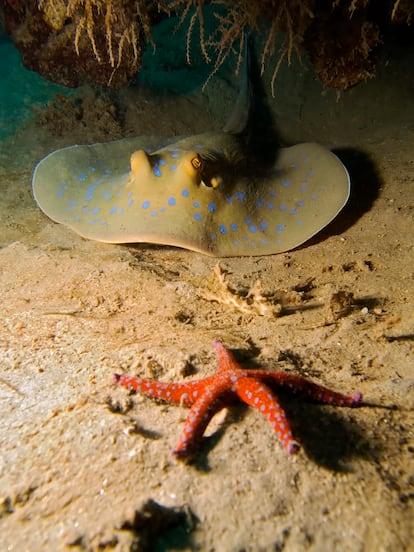
Another exceptional place is Naama Bay. The southern coast of the Gulf of Aqaba — between the island of Tiran and the Ras Mohammed National Park — has some of the most impressive marine settings in the world. Its crystal-clear waters and varieties of exotic fish that swim through the colorful coral reefs have made this area a diving paradise. Sharm el-Sheikh occupies a privileged position to offer sun and beach holidays with a family-friendly atmosphere and many diving options.
However, the true spirit of the Sinai is far from the bustle of the coast: between steep reddish peaks and immense expanses of sand, the Bedouin people preserve their traditions. On a starry night, surrounded by the silhouettes of the mountains, the traveler understands why the Sinai has a charm that’s impossible to resist.
Sign up for our weekly newsletter to get more English-language news coverage from EL PAÍS USA Edition
Tu suscripción se está usando en otro dispositivo
¿Quieres añadir otro usuario a tu suscripción?
Si continúas leyendo en este dispositivo, no se podrá leer en el otro.
FlechaTu suscripción se está usando en otro dispositivo y solo puedes acceder a EL PAÍS desde un dispositivo a la vez.
Si quieres compartir tu cuenta, cambia tu suscripción a la modalidad Premium, así podrás añadir otro usuario. Cada uno accederá con su propia cuenta de email, lo que os permitirá personalizar vuestra experiencia en EL PAÍS.
¿Tienes una suscripción de empresa? Accede aquí para contratar más cuentas.
En el caso de no saber quién está usando tu cuenta, te recomendamos cambiar tu contraseña aquí.
Si decides continuar compartiendo tu cuenta, este mensaje se mostrará en tu dispositivo y en el de la otra persona que está usando tu cuenta de forma indefinida, afectando a tu experiencia de lectura. Puedes consultar aquí los términos y condiciones de la suscripción digital.
More information
Archived In
Últimas noticias
Most viewed
- Reinhard Genzel, Nobel laureate in physics: ‘One-minute videos will never give you the truth’
- Oona Chaplin: ‘I told James Cameron that I was living in a treehouse and starting a permaculture project with a friend’
- Pablo Escobar’s hippos: A serious environmental problem, 40 years on
- Charles Dubouloz, mountaineering star, retires at 36 with a farewell tour inspired by Walter Bonatti
- Why we lost the habit of sleeping in two segments and how that changed our sense of time










































